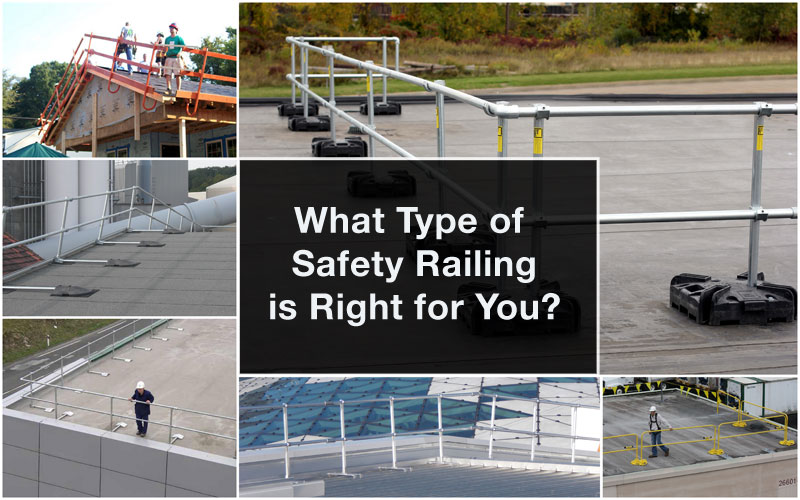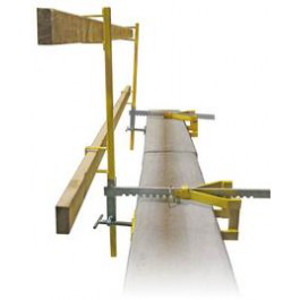What Type of Railing is Right for You?

Safety railings are the best form of fall protection. Once safety railing is in place, nobody needs to think about using them, they're just there. Yes, they need to be maintained in good condition,
but workers don't need to remember to put them on, adjust them properly, worry about fall distance or anchorage point strength.
Yet, whether it's because companies feel rails are too expensive, they don't know they can buy temporary rails rather than have a carpenter build them, or because they are unaware of the different types of rails available to them, many companies still resort to personal fall arrest when railing would serve them better. Worse yet, some forego fall protection altogether.
Next time you drive by an office building, warehouse, or manufacturing facility, take a look upward. Are there any protective systems on the roof that you can see? Are the parapets high enough to prevent a fall, if there are any parapets at all? The answer to these questions will be "no" for the vast majority of buildings. Do you believe that maintenance workers, HVAC contractors, roofers, electricians, or any other personnel that need to be up there are taking the time to put on fall protection? Maybe for some very safety-conscious companies, but again, the answer for the vast majority of those companies will be "no".
You Don't Want to Penetrate the Roof
So, what is available? Well, that depends on your needs. Many building owners are concerned with penetrating the roof. Regardless of the design of what is being installed, any penetration is an opportunity for water intrusion. That's why non-penetrating roof railing systems exist. These systems use specially designed counterweights or pole weights to provide the protection needed for your employees while utilizing padded surfaces in order to avoid damage to your roof membrane.
Attaching to Parapets May Be an Option
Other options include a roof parapet railing for situations where parapets exist, but are not high enough to offer protection. These clamp onto the parapet, giving you the necessary height to meet regulatory requirements. One of the added benefits of these rails is that roof repair can be done right to the edge of the roof without disturbing the rail system while a weighted, non-penetrating rail may need to be moved in order to get to the area that needs to be repaired. In such a case, alternate fall protection would still be required.
How Concerned Are You About Building Aesthetics?
When it comes down to it, though, the reason many buildings have no rails on their roofs has nothing to do with cost or safety. The most common reason is aesthetics. Let's face it, when you build a beautiful, state of the art facility, who wants to see some clunky railing all along the top, right? Well, while that is not a valid excuse for exposing employees to fall hazards (not to mention the fact that many systems are aesthetically pleasing), there are products that can help achieve safety while maintaining your building's aesthetic value. Collapsible railing can be installed along the perimeter of your building and kept hidden from sight when not in use, for instance.
Stay Away from Welding on a Roof
It's also important to note that many of these railings require no welding for installation. This will come as a relief to building owners concerned with performing any type of hot work on their roofs. And, while it may seem that welded options would be better, in reality, many of the railings discussed in this article are just as durable as welded solution. In addition, since many are modular, it can be easier – and more cost-effective – to repair or replace a small section of damaged rail.
Railing for the Construction Industry
Speaking of cost-effectiveness, for years residential construction failed to meet regulatory requirements for fall protection citing how the cost of using such equipment would negatively impact the price of the home and the simple lack of available solutions. While OSHA has not enforced fall protection standards on residential contractors the same way they do commercial contractors, the enforcement is coming. And, now, there are no excuses.
Whether a contractor chooses to use peak anchor plates or a temporary construction railing system, solutions are now available and affordable. HUGS guardrail offers portability, easy installation, and the choice or reusable brackets or disposable brackets that can just be sealed up in the roof.
Residential construction workers should be treated as if their lives are of the same value as commercial construction workers – because they are.
Whatever your task, whatever your industry, if you work at heights, consider guardrail as your primary means of protection. It is effective, cost-efficient and you can practically guarantee regulatory compliance once it is properly installed. Install rail to give yourself peace of mind.



